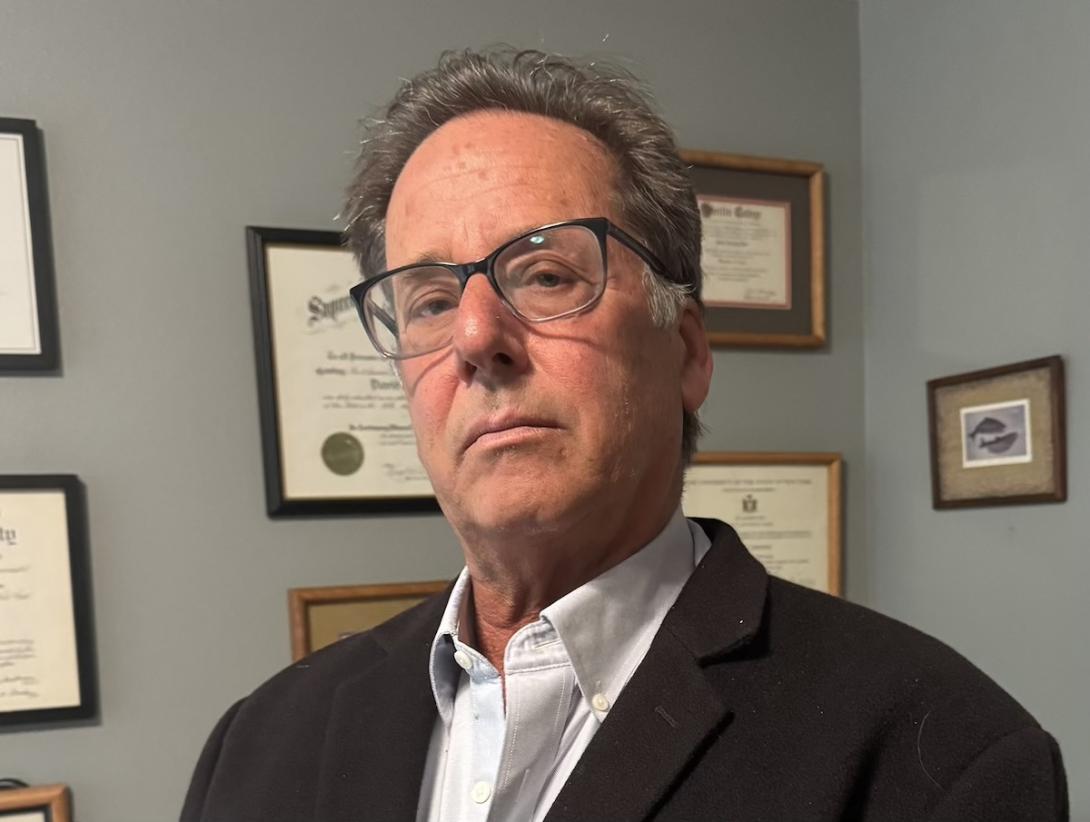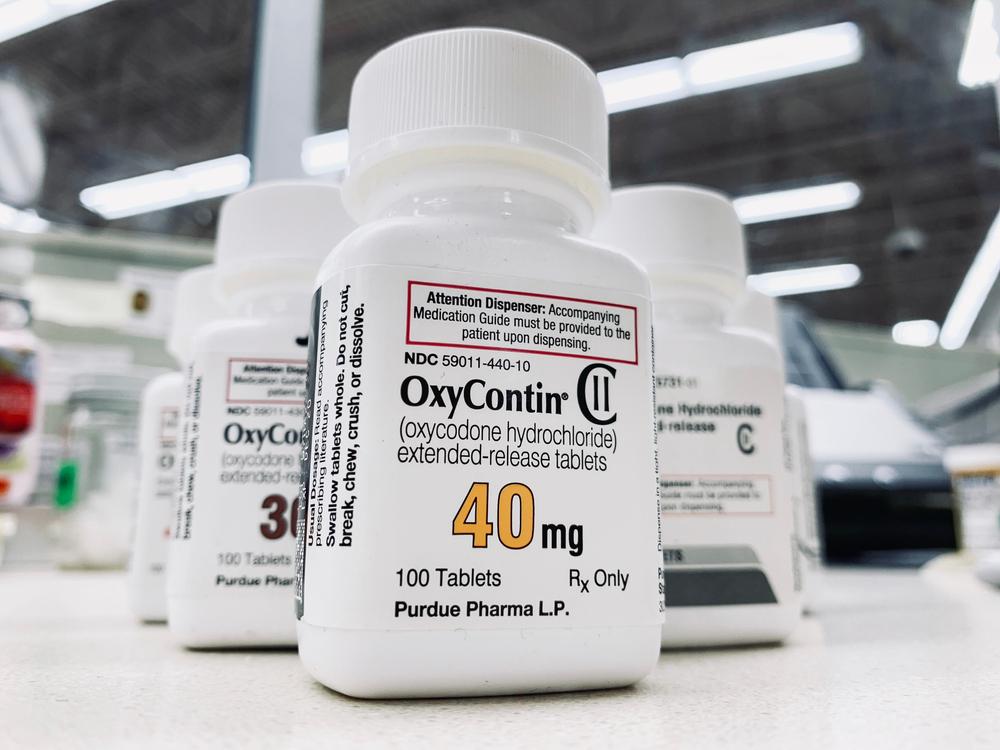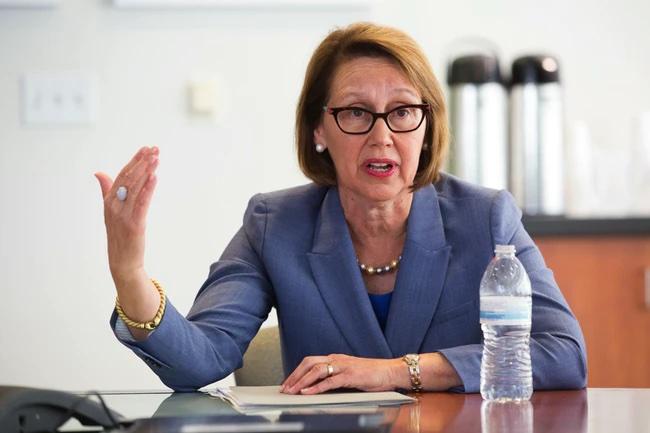
The Oregon Justice Department attorney who spent much of the last 20 years investigating and suing notorious opioid maker Purdue Pharma is going public to blast a proposed $7.4 billion global settlement with the company, saying it is too lenient.
David Hart’s decision to speak out with The Lund Report — and, subsequently, in an op-ed in The Oregonian/Oregonlive — came mere days after he clocked out for the last time in downtown Portland.
His take is significant because he’s been a national leader in the Purdue case and other consumer protection cases against pharmaceutical companies. Until his retirement, he was on the multistate team that has been negotiating the proposed settlement.
Now able to speak freely, he does not hold back.
“Look, Purdue was the worst,” Hart said. “Purdue and the Sacklers lit the fire that started the opioid epidemic. They destroyed lives and caused great harm to society. And the Sacklers have never taken responsibility.”

In multiple interviews, the longtime consumer protection attorney highlighted the open questions around how the decades-old saga of Purdue Pharma will end. In pursuit of higher profits, the company created an unparalleled public health disaster — one that continues to reverberate around the state of Oregon and on the streets of downtown Portland.
Hart is urging Oregon Attorney General Dan Rayfield — and his counterparts in other states — to reject the deal, calling it a “terrible precedent.”
Under the settlement now pending in a New York bankruptcy court, Purdue would pay about $900 million, while the company’s owners, the Sackler family, would pay up to $6.5 billion.
Oregon would get about $58 million — a tiny fraction of the $13 billion the state says Purdue and the Sacklers owe Oregon to address the damages they’ve caused.
But the deal would leave much of the Sackler family fortune intact. Though the opioid death rate has declined recently, last year an average of 150 Americans still suffered fatal overdoses due to o each day. As the death toll mounts, no member of the Sackler family has faced criminal prosecution.
Looking back at his work for the state, Hart is haunted by the thought that, more than a decade ago, decisions by state and federal officials that essentially went easy on Purdue led to untold thousands of additional people becoming addicted and dying due to continued corporate wrongdoing. And he doesn’t want to be associated with a deal that repeats that earlier mistake.
Hart is not the only one raising concerns about the deal. Former federal prosecutor Rick Mountcastle, who investigated Purdue and tried to file felony charges against executives only to be forced to negotiate misdemeanor plea deals, has come out against the settlement.
“I am beyond disgusted,” Mountcastle, now an attorney for a Washington, D.C. law firm, told The Lund Report. “Disgusted is too weak a word. The Sacklers were running the show and they walk away taking no responsibility for running a criminal operation that harmed hundreds of thousands of lives.”
Rayfield, who took office Dec. 31, 2024, says he’s been wrestling with the same concerns Hart raises. That’s why, in January, he chose not to sign on to a press release put out by his counterparts in several other states touting the proposed deal.

The terms of the settlement are intended to put pressure on smaller states, in effect coercing them to agree to the deal, Rayfield said in an interview last week, calling it “horrible, bad policy.”
He said the settlement could lead to more like it down the road, with terms that potentially deprive smaller states and some individuals of their right to justice — which Rayfield called “incredibly frustrating …Without some of this coercive language in there, it would be a very easy decision to opt out and not take this settlement.”
But for Oregon to pursue this case could mean it doesn’t pursue different ones, and it’s unclear that the outcome for Oregonians would be better, Rayfield said: “So we have a couple of attorneys in-house that are evaluating this.”
The final draft of the proposed settlement was shared with state attorneys general around the country on May 8. They have 30 days to decide whether to sign on.
Sales tactics led to addiction
Purdue released OxyContin in 1995. At the time, opioid painkillers were generally prescribed for end-of-life care and the intense pain of cancer patients.
Oxy was different, according to the army of sales reps Purdue sent out across the country. These pills dissolved slowly, they said, controlling the release of the oxycodone inside and making it less addictive.
That marketing created a goldmine for Purdue, with total sales eventually exceeding $35 billion. But it was also a public health disaster. Despite Purdue’s reassuring words, Oxy proved to be highly addictive. Coal miners, high school jocks, construction workers and other average workaday people found themselves craving the high and unable to face the pain of withdrawal.
People were dying from opioid overdoses, nearly 250,000 of them between 2009 and 2019. Despite a recent decline linked to the spread of the overdose-reversal medication narcan, more than 150 Americans still die every day from opioids.
In Oregon, drug overdose deaths hit an all-time high of 1,723 in 2023. According to the Oregon Health Authority, opioid users often graduate to heroin or methamphetamine or fentanyl, or a mix of all four.
The scale of the human toll is evident on streets of Portland and many other cities.
Hart, who commuted by bicycle to his downtown office, said “I saw it every day. I’m no sociologist, but there’s clearly a connection between addiction, homelessness and mental illness.”
Purdue did not respond to a request for comment.
Settlement shields the Sacklers
In January, several states’ attorney generals announced an agreement in principle for a settlement portrayed as worth $7.4 billion, to purportedly end the long-running case.
Hart won’t divulge confidential or privileged discussions. But what’s come out publicly about the deal, he said, shows that it does not go far enough. His primary concerns are that the settlement:
- Funds Sacklers’ legal defense: Much of the Sackler’s settlement payment is supposed to go to fund drug treatment and addiction programs. But under this settlement, as much as $800 million of the payout will be handed back to the Sacklers to cover their legal fees and the cost of additional settlements. To Hart and other critics, that’s a nonsensical giveaway to the perpetrators. Meanwhile, any of those funds not spent on legal defense would go to the settlement payout — effectively aligning the state attorneys generals’ interests with those of the Sacklers.
- Lets the Sacklers keep their money: Although the Sackler family will pay out as much as $6.5 billion, they’ve already extracted far more than that from Purdue.
- Is not enough: Though the settlement would pay Oregon $58 million, that’s significantly less than the $74 million Oregon was lined up to receive under a settlement approved in 2022. That settlement was blown up last year by a ruling of the U.S. Supreme Court, which struck down an aspect of the settlement that had led to a smaller proposed payout. The Supreme Court essentially encouraged the states to seek a better deal. But while the proposed settlement adds $1 billion onto the payout, that figure is misleading as it includes the newly proposed $800 million legal defense fund for the Sacklers.

For Hart, the proposed settlement would be an unsatisfying end to an underdog story. Government attorneys and trial lawyers engaged in a 20-year pursuit of Purdue even as the company employed deceptive marketing and used its clout and wealth in ways that at least vastly worsened the country’s opioid crisis — and in the eyes of many, created it.
The company not only could afford high-priced consultants and lobbyists, but also it paid some of the highest high-powered lawyers in the country to fend off Hart and other attorneys pursuing Purdue. Among the company’s hires were former federal prosecutor Rudy Giuliani, Eric Holder, the eventual U.S. attorney general under Barack Obama, former federal prosecutor and chair of the Securities and Exchange Commission Mary Jo White, and Patrick Fitgerald, the former federal prosecutor who led high-profile cases against national security aide Scooter Libby in 2006 and Illinois Governor Rod Blagojevich in 2008.
Night school led to transformative role
A native New Yorker, Hart worked for 11 years as a physical therapist before deciding to become a lawyer.
He got accepted at Lewis & Clark and attended night classes. In his third year, he was selected for a clerkship with the Oregon Justice Department. He found a home in the department’s consumer protection arm.
“My first impression was that he was cocky,” said Cheryl Pelligrini, who was running the consumer protection unit at the time. “On one of his first days, I remember he came in wearing a jacket, a white shirt with no tie and dress shoes with no socks. I was like, ‘Where do you think you’re working?’”
Pellegrini quickly became a fan. With his emphasis on the health care industry and his deep knowledge of the field — his wife was a professor of pharmacy — Hart set a new standard for what a DOJ attorney could do.
He also changed the way Oregon pursued wrongdoing by Big Pharma. He took on some of the biggest names in the business – Pfizer, Stryker, Johnson & Johnson – accusing them of making phony marketing claims, selling drugs, medical hardware and other products that didn’t work.
“Before David came in, a lot of our work in the consumer protection unit was based on consumer complaints,” Pellegrini said. “What David did was very different. He just had a very different awareness of what was going on in health care and the relationship between the FDA, pharma and customers.”
Hart helped Oregon become a leader on the national scene
In 2004, Hart joined the small group of state attorneys spearheading the litigation against Purdue. Over the next two decades, he became a leader in those efforts.
Among the state attorneys pursuing Purdue, Hart “was the conscience of the group,” said attorney Gillian Feiner, who oversaw opioid litigation for the state of Massachusetts and worked on the Purdue case with Hart. “He’s kind of a bulldog. He’s fearless and he’s got a very, very strong moral compass.”
Similarly, an assistant attorney general for another East Coast state who asked not to be named, told The Lund Report that the small group driving the Purdue litigation came to rely on Hart’s grasp of the situation — notwithstanding his trademark self-deprecation.
“He starts many sentences with, ‘I’m only a physical therapist and night school lawyer’ ... That’s how he views himself,” the lawyer said. “And I’ve learned that when he starts a sentence that way, you better listen closely, because it’s often an important insight.”
Last year, he was presented an award by the National Association of Attorneys General at a conference in Washington, D.C., where his boss, Oregon’s then-Attorney General Ellen Rosenblum, described him as “instrumental” to national efforts to hold pharmaceutical companies accountable.
To The Lund Report, Rosenblum described Hart’s contributions as “nothing short of phenomenal,” adding that “Oregon is so lucky to have had him to lead all the opioid cases — and particularly the settlement negotiations. He was an integral part of every settlement we've obtained.”
Hart says he’s going public now because as he reflects on his career, he’s all too aware of things that could have been done better — and earlier — to prevent the massive death toll involved with the opioid crisis.
A threat underestimated
In 2004, Oregon and several other states began investigating Purdue Pharma following media accounts documenting a surge in addiction around OxyContin.
Their investigation found that the company was aggressively and unlawfully marketing OxyContin as a safe and effective painkiller — but downplaying the potential for abuse and addiction.
On May 8, 2007, Oregon and other states announced a settlement with the firm calling on it to put a stop to misleading marketing used to promote the drug.
Two days later, the federal government announced its own settlement, based on an investigation it hadn’t told the states about.
The federal effort included a criminal case against Purdue Frederick, a Purdue Pharma affiliate. Purdue Frederick pleaded guilty to a felony charge of misbranding OxyContin with the intent to defraud or mislead. It agreed to pay $600 million in fines.
Three executives of the company pleaded guilty to a misdemeanor charge of misbranding. None of the three did any prison time, said Mountcastle, the prosecutor in the case. He’s said he and his fellow prosecutors were told to settle the probe as a misdemeanor rather than file felony charges.
The states’ settlement secured a court injunction prohibiting Purdue from deceptive marketing and requiring them to take action when alerted to misprescribing. Purdue had to cover the states’ investigative costs, but the settlement let the firm off with no fine.
Because the states were not aware of the federal effort, their grasp of the problem and their ability to demand terms was limited, Hart says.
He shakes his head at the memory. “It was ineffective and lacked teeth,” he said of the settlement. “It failed to stop future misconduct. I think we were a little bit naïve.”
In part, that’s because states were accustomed to dealing with companies that complied with legal settlements and court orders.
However, that’s not what happened with Purdue. The company didn’t change its ways. Instead, Hart said, Purdue “doubled down.”
“Purdue and the Sacklers lit the fire that started the opioid epidemic. They destroyed lives and caused great harm to society. And the Sacklers have never taken responsibility.”
Misleading sales tactics continue while deaths escalate
By 2011, investigations by journalists and Congress documented how Purdue had paid massive sums to respected professional associations, pain groups and hospital watchdogs that then essentially helped push OxyContin by supporting weak prescribing guidelines. That, in turn, helped lead to more people becoming addicted.
Hart had insisted on language in the 2007 settlement that gave the Oregon Department of Justice the right to obtain internal Purdue documents, and he launched a new investigation on his own.
He and his Oregon colleagues painstakingly cross-referenced Purdue’s marketing to physicians in the state with disciplinary actions by the Oregon Board of Pharmacy, finding that even when the company was alerted to red flags with the doctors who were clearly overprescribing to patients, they kept marketing to them.
And people were dying as a result.
In February 2016, Hart testified before the U.S. Senate Finance Committee about the opioid crisis.
The key to solving the epidemic was to take the manufacturers’ profits and huge salaries and put their executives behind bars, he said. That would quickly ‘disincentivize” the opioid business.
In October 2016, based on the multiyear investigation with his colleagues, Hart sent a letter to a Purdue vice-president and attorney notifying the company that it was violating the terms of the deal.
He included example after example in which Purdue kept working with doctors in Oregon to prescribe more opioid painkillers despite being warned of problems with what the doctors were doing — rather than cutting them off. It was not just state regulators finding problems; at times it was Purdue salespeople red-flagging the doctor’s conduct.
The company’s response to Hart was sent by Patrick Fitzgerald, the former federal prosecutor who’d repeatedly made national headlines. With exhibits, it spanned 105 pages and politely disagreed with Hart’s allegations, saying the company hadn’t committed any violations.
Meanwhile, word of Hart’s solo investigation was getting out. A doctor and a producer for the investigative television news show, 60 Minutes, requested the records he’d obtained from Purdue — only to have Purdue in 2017 sue Oregon successfully in an effort to bottle them up.
Hart began working with his counterparts in other states to prepare a second case against Purdue.
States, federal government again go to court
In 2018, Oregon and several other states as well the federal Justice Department filed separate lawsuits against the company. Like many other states, Oregon claimed that Purdue was violating the terms of the 2007 settlement.
This time, there was no longer any question about the devastating impact of Oxycontin and other opioids. Every day, more than 115 Americans were dying from overdoses, according to the complaint.
Oregon was “awash in opioids,” it said. Health care providers wrote more than 3 million opioid prescriptions in 2015, enough for nearly every adult Oregonian to have their own bottle of pills. More than 230 Oregonians died of opioid-related causes in 2013, quadruple the number of 2000, according to the complaint.
The Oregon suit alleged Purdue lied to the Oregon pharmacy board about its felony convictions to keep its license. The suit also accused Purdue of crimes and racketeering.
The complaint did not name any of the Sacklers as defendants, but Oregon subsequently filed two additional lawsuits naming the family members as defendants.
Any hope for a quick settlement vanished in September 2019, when Purdue filed for bankruptcy, claiming it was spending $5 million a week to defend itself.
The bankruptcy filing put every lawsuit filed against Purdue and the Sacklers, including Oregon’s, on hold.
In court, the Sacklers proposed to pay billions into a settlement fund that would be shared among addiction treatment programs around the country. In return, the Sacklers wanted permanent protection, or immunity, from all future claims.
The Sacklers offered $3 billion, and a group of Republican states plus Michigan agreed.
But Oregon and other states headed by Democratic attorneys general, plus Idaho, held out for more, pushing the proposed settlement up to $4.35 billion.
Hart then became a leader in a group of attorneys for eight holdout states and Washington, D.C. — “The Nine,” as they were known, that pushed Purdue for an even better deal.
The holdouts’ position was risky. If Purdue deemed their demands excessive, the company could ask the judge to essentially ignore the dissidents and enforce upon them the earlier, weaker terms.
In other words, the states essentially were negotiating under threat — a dynamic that led to a smaller payout than if there were no such clause.
Despite that, Oregon and the other holdouts pushed the overall settlement figure to as much as $6 billion — doubling the initial settlement amount.
Not only that, but Hart, backed by his boss Rosenblum, successfully pushed to allow museums and other recipients of Sackler largesse to chisel off the family’s name from buildings and wings they had funded. Oregon also pushed for a public repository, or library, of internal Purdue documents to be established to provide transparency and help society learn lessons from the opioid crisis.
Hart was fun but “always outspoken,” Feiner said, adding; “He can be a pain in the ass when you’re trying to do something by committee.”
The Sacklers’ $11 billion withdrawal
Hart’s sense of outrage about Purdue’s actions intensified in December 2019 when the news broke that the Sackler family had over the prior 10 years pulled more than $11 billion out of Purdue. While the Sacklers haggled over a settlement in the $4 billion range, they already had secretly sucked a much larger fortune out of Purdue.
The Sacklers put much of the $11 billion into overseas tax shelters, while they continued to play hardball in court.
In 2021, the Oregon Justice Department opposed Purdue’s bid to shield the firm and the family from all opioid-related claims and future litigation, with Rosenblum calling it a “lifetime legal shield,” for the Sacklers, adding that they “pay too little and keep too much.”
Nevertheless, the bankruptcy court approved the plan. But last June, the U.S. Supreme Court threw it out, essentially concluding that the liability shield was unlawful unless all claimants had agreed to the deal.
The court’s opinion was clear that now a better settlement could result: “If past is prologue … there may be a better deal on the horizon.”
Negotiations resumed. But today, the payout hasn’t changed much. While the new deal adds about $1 billion onto the payout, that figure includes the newly proposed $800 million legal defense fund for the Sacklers.
The new legal defense fund— which, if not spent, goes to the states that agree to the settlement — creates a new dynamic, one that adds to the pressure on Oregon and other states to agree to the deal.
Hart thinks the state should reject the bankruptcy settlement and continue to pursue the Sacklers, perhaps joining with other states to do so.
Hart’s decision to go public adds to the scrutiny on Rayfield. The new attorney general told The Lund Report he’s started reaching out to other states to see what his counterparts are planning to do, even as his own attorneys map out options.
Rosenblum, Hart’s old boss, said she had agreed with Hart that aspects of the settlement were objectionable, but has been out of the loop since leaving office.
“Out of respect for the new attorney general I am not going to weigh in publicly on what I think of the proposed settlement,” she said. But over her three terms as the state’s elected top lawyer, she added, “I don't think I ever disagreed with David Hart.”
Deal raises troubling questions
During his career, Hart brought in close to $750 million through court cases and settlements, but the Purdue case still nags at him, raising troubling questions of corporate accountability, injustice and wealth.
When Oxy sales were at their peak, 25,000 people every year were suffering fatal overdoses of the drug. That’s more than the total population of Roseburg or West Linn.
According to the U.S. Justice Department investigation, Purdue knew full well what it was doing, knowingly relying on sketchy prescribers to boost sales..
But the Sacklers continue to deny responsibility: “
David Sackler told a congressional committee in 2020 that the family was willing to settle the many lawsuits against it for billions, but “we deny liability and are vigorously contesting these claims.”
In light of all this, Hart can’t help but think that in 2007, states including Oregon signed on to a weak deal that did little to curb the eventual death toll — and now they’re considering a similarly weak one.
“The deal allows the Sacklers to keep a significant portion of their ill-gotten gains,” he said. “I wouldn’t want to be associated with a deal that doesn’t hold the Sacklers accountable.”